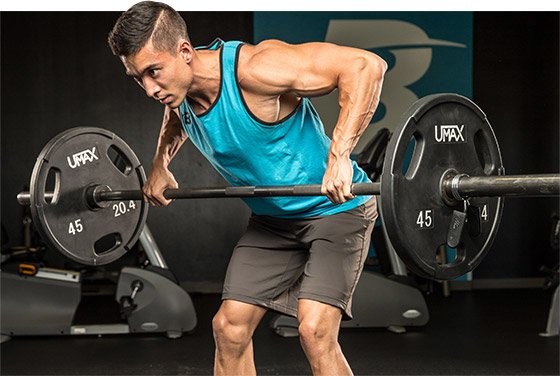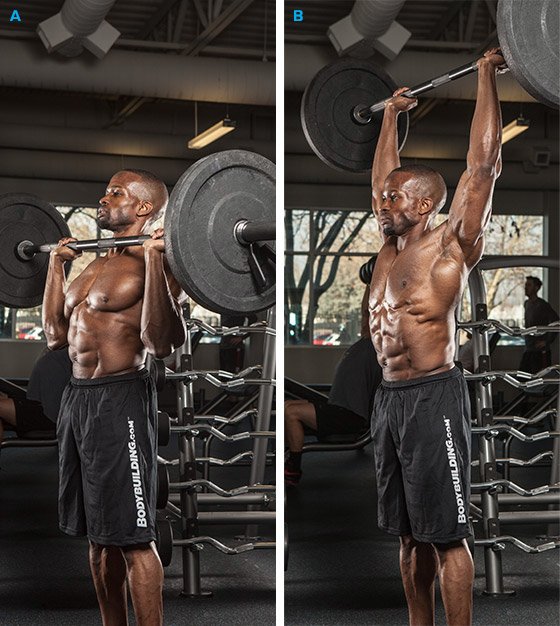"How much ya strict press?"
That question may sound funny today. Most of us would far prefer to test ourselves in something—anything—other than an overhead lift. Bench? Let's go. Squat? Great. Even how much you curl has a place on your resume. But shoulders? Man, that's for pumps. Who wants to risk an injury?
It wasn't always like this, though. Once upon a time, the amount you could put over your head was the question—and especially how much you could strict press. I'm talking no crazy over-arch, no leg drive, and a full range of motion from collarbone to lockout.
In my experience, this is one of the hardest things you can do in the gym, and I take great pride in the fact that, over time, I've been able to work my way up to a 225-pound max effort for the strict press. With my 6-foot-8 wingspan, that's no small feat!
Here I am, recently pushing 210 for a smooth triple.
Lee Boyce Strict Press 210 x 3
Watch The Video - 00:38
Let me be clear: Training to reach 200 wasn't as simple as just getting under the bar and doing it. It took a lot of planning, a focus on shoulder health as well as shoulder strength, and the willingness to put my ego aside. But if you've been in the iron game for a while, you know that that type of approach can feed positively into just about any other strength, physique, or athletic goal.
If you're still reading, then maybe you're starting to wonder if maybe, just maybe, a big overhead press is more of a possibility than you'd previously thought. I'm here to say it is!
Here's what you'll need to get it:
Ingredient 1 An upper back that can "shoulder" the load
When it comes to the overhead barbell press, strength is only one ingredient. If your shoulder isn't stable, the lift isn't stable—and it won't be going up. You may be able to get away with some lighter loads, but you can say goodbye to going heavy without paying a visit to snap city.

Your shoulder stability is going to be determined by how strong your upper back is. All four of your rotator cuff muscles attach on the scapulae, so pulling exercises with proper technique are going to be a major element in pain-free pressing. This is especially important if you're a tall or long-armed lifter like I am, since stress forces will be higher due to your lever arm length and increased time under tension.
I'd recommend sticking to a 2:1 ratio of pulling exercises to pushing exercises in your routine, and be sure to work in both a horizontal and vertical plane of motion when pulling. Here are exercises I personally like to use to improve scapular stability:
Ingredient 2 Scapulae that can do more than lock down
So your shoulders feel nice and stable. That's great, but it's not going to be enough to get a heavy barbell overhead. Having the ability to mobilize the scapulae is also extremely important to being able to push a load along the safest, strongest trajectory. As the humerus (upper arm) moves, there should be a lesser but corresponding degree of movement at the shoulder blade.
That means it's wrong to keep your shoulder blades "pinned" when pushing a weight overhead. Your scapulae should actually migrate upward and outward as your arms raise. A downside of bench pressing is that it reinforces the "stay locked down all the time" feeling. Of course it's necessary during that lift for your safety and performance, but it becomes a problem when you keep your scapulae similarly locked down during push-ups and rowing movements, too.
This video goes into greater detail:
Lee Boyce on Scapular Mobility
Watch The Video - 03:37
The solution: Get those scapulae moving, and strengthen the muscles that help them move, like the serratus. Here's how:
-
Pin your shoulder blades at the back of a rowing motion, but not the front. Let the weight pull your shoulders forward.
-
Perform push-ups—lots of them—but with a little extra "push" at the top. Unlock your shoulder blades and get your body as far away from the ground as possible.
-
Perform one-arm push-ups, one-arm rows, and single-arm dumbbell shrugs in addition to the two-armed varieties. All of these train scapular mobility.
-
If your overhead-push goal is really ambitious, consider some additional serratus work, like the serratus front raise.
Lee Boyce Serratus Front Raise
Watch The Video - 00:17
Ingredient 3 A front side that can get out of the way
You may have noticed that we haven't talked much about your actual shoulder joint so far. Naturally, the ball-and-socket joint of the shoulder needs to be strong through a full range of motion to do a true strict press. Otherwise, you'll end up doing the classic "standing lean-back incline press" I show in this video, which is guaranteed to be bad news for your back.
Lee Boyce on Shoulder Press Mistakes
Watch The Video - 05:04
If you just shouted "Amen!" at your screen (I thought I heard something), then the time has come for you to work on the tissue quality—not just the tissue size—of your beach muscles. Having restrictions in movement because of tight muscles of the chest, front deltoids, and even hips can create a tidal wave of negative effects on your standing strict barbell press. The most common compensation is an overarch in the low back to make up for a poor bar position overhead.
Luckily for you, I've already written an entire article about back hyperextension and how to prevent it. The upshot is that you need to get reacquainted with one of the great movements everybody knows they should do, but no one does: the shoulder dislocate.
Doing this regularly, along with practicing the press with proper form using light loads, can help ingrain the correct patterns and angles into your muscle memory.

Standing Barbell Shoulder Press
Ingredient 4 Automatic technique
So we've laid the groundwork that will allow you to do the lift. What comes next, as I said in the previous section, is practice. That's where your ego can be your worst enemy. You need to use light loads until you master the geometry of the strict press. Here's what that geometry consists of:
-
A full range of motion: There's no point in half-repping your overhead press. All it will do is make tight muscles tighter and keep weak links weak. If you can't touch bottom (your collarbone) or go to full lock-out without experiencing pain, something's wrong. Refer to the above sections, work on the weakness, and lower the load when you're ready to try again.
-
Perfect elbow position for you: I use a hand grip that's just outside shoulder width for my standing press. My elbows stay tucked right under the bar, no more than an inch in front of it. As I press, I actively try to rotate the elbows so that they face outwards by the end of the lift. This positional shift allows the middle delts to become more involved, which makes for a stronger lockout force, since the elbows will remain under the bar.
No matter what width works best for you, your elbows should not be bent at the top of the lift. You should be able to hold the load locked out above your head for two minutes if you want to.
-
Head through the window: When your arms are above your head, you need to get your head "through the window" they create as soon as possible. This will position your spine and shoulder blades under the load as early as possible, creating a foundation that will give you more drive.
-
No cheating: Sorry, but this really needs to be emphasized. If you've gotta cheat, you're too weak—plain and simple. Don't do all the stuff that those lifters used to do when the clean-and-press was an Olympic event. Don't use your legs, don't lean your back, and don't cut your ROM.
If you really want to get strong, you'll need to dissect the lift and focus on the basics. Sure, it's frustrating to start at the bottom, but the results will speak for themselves when it comes to your lifting numbers and physical development. You're welcome.

